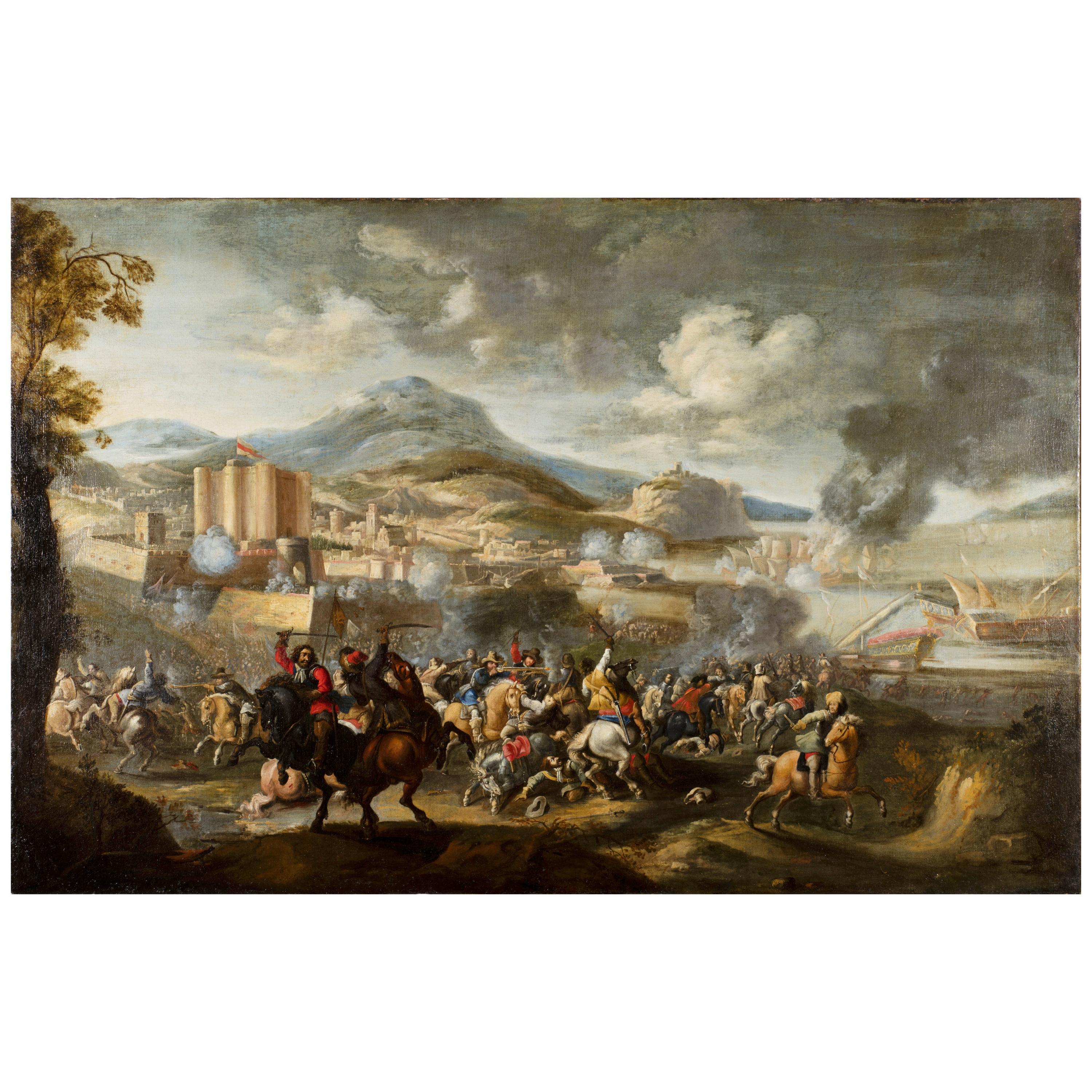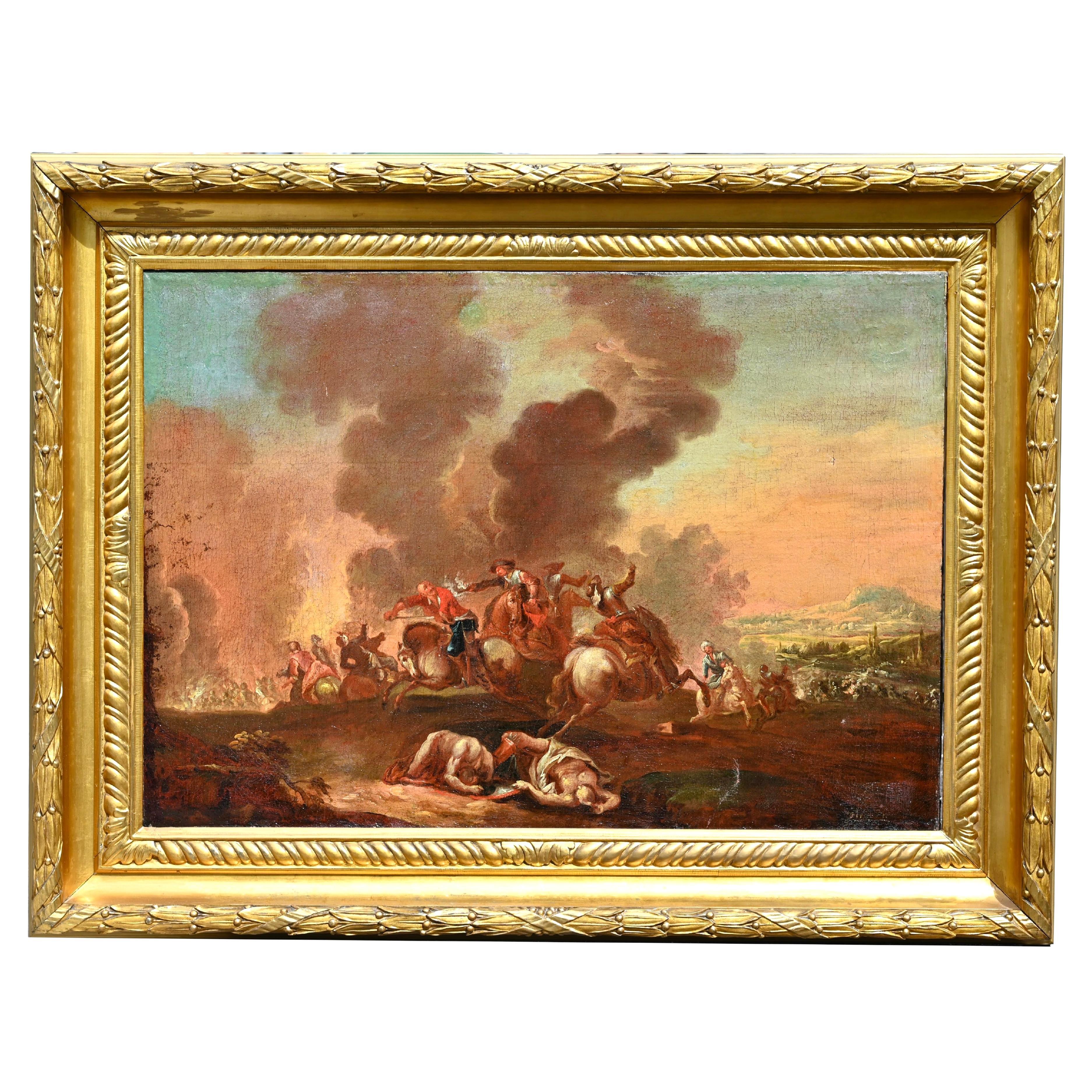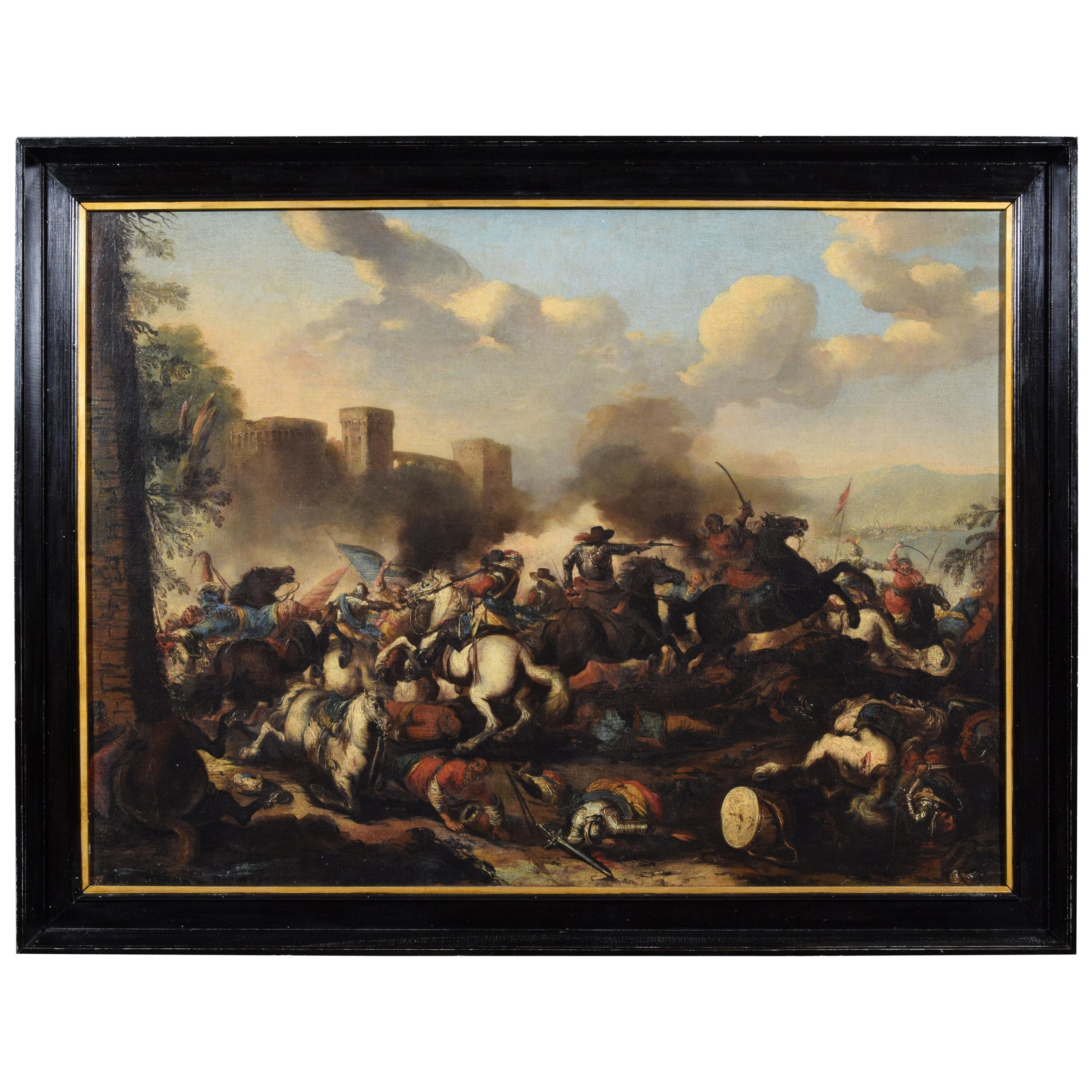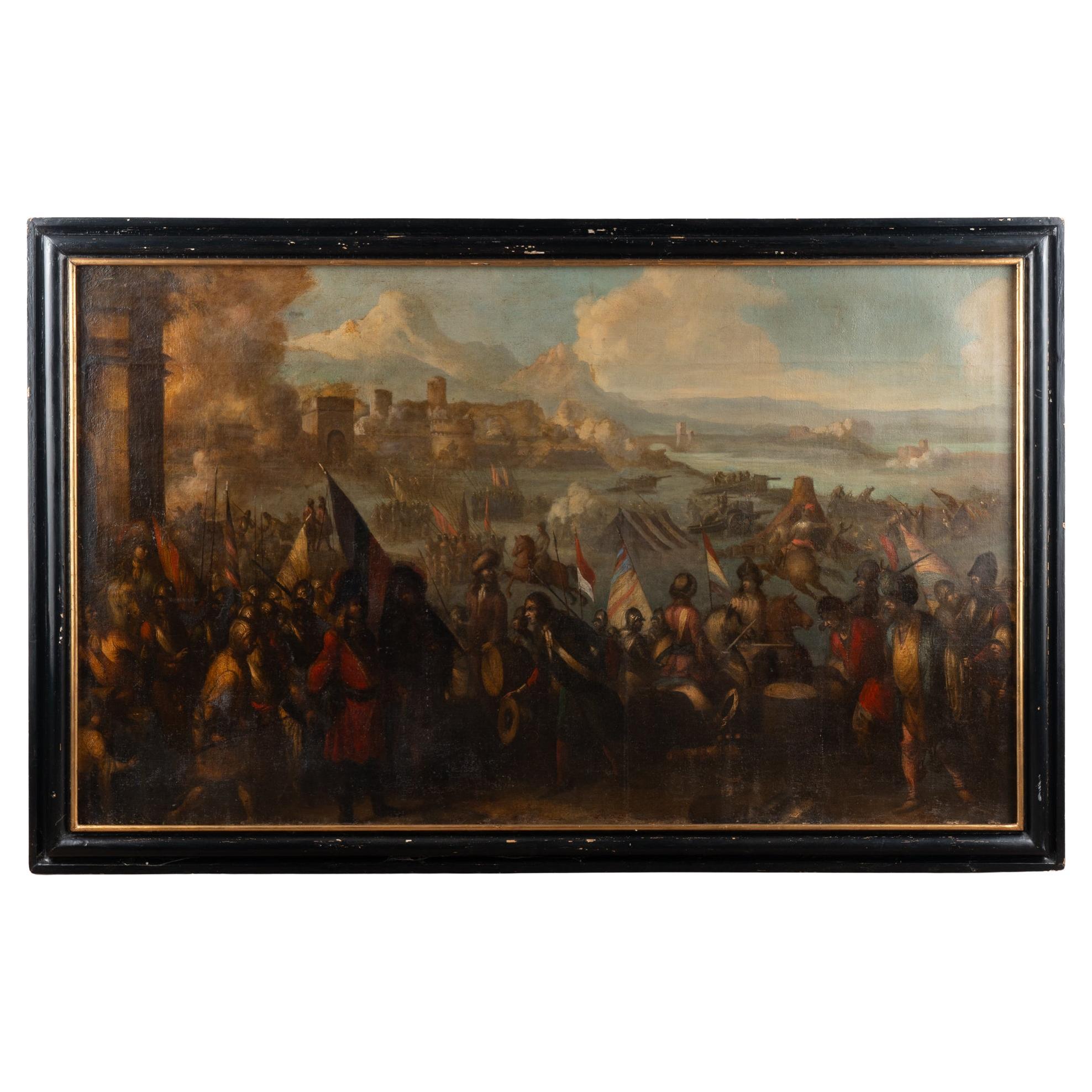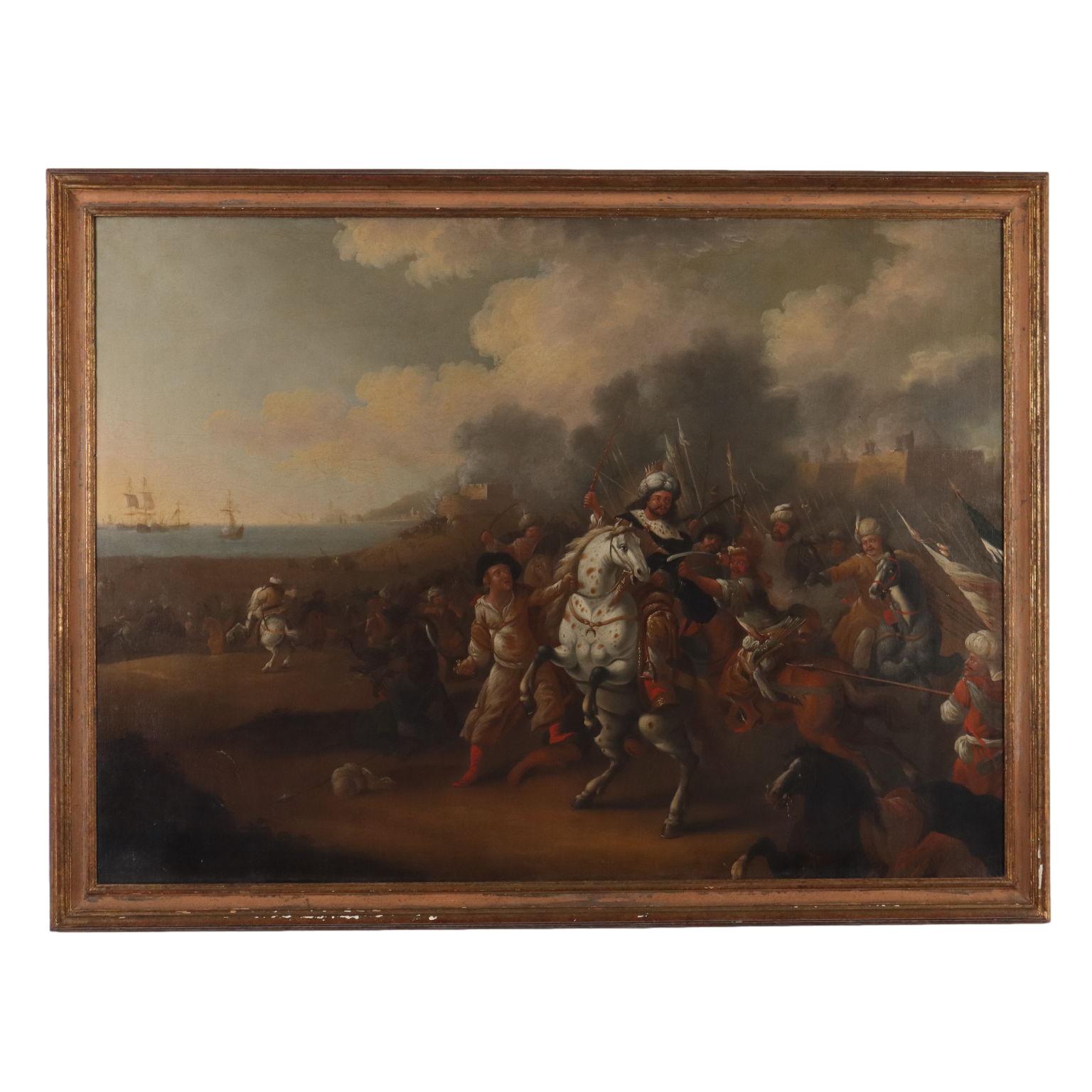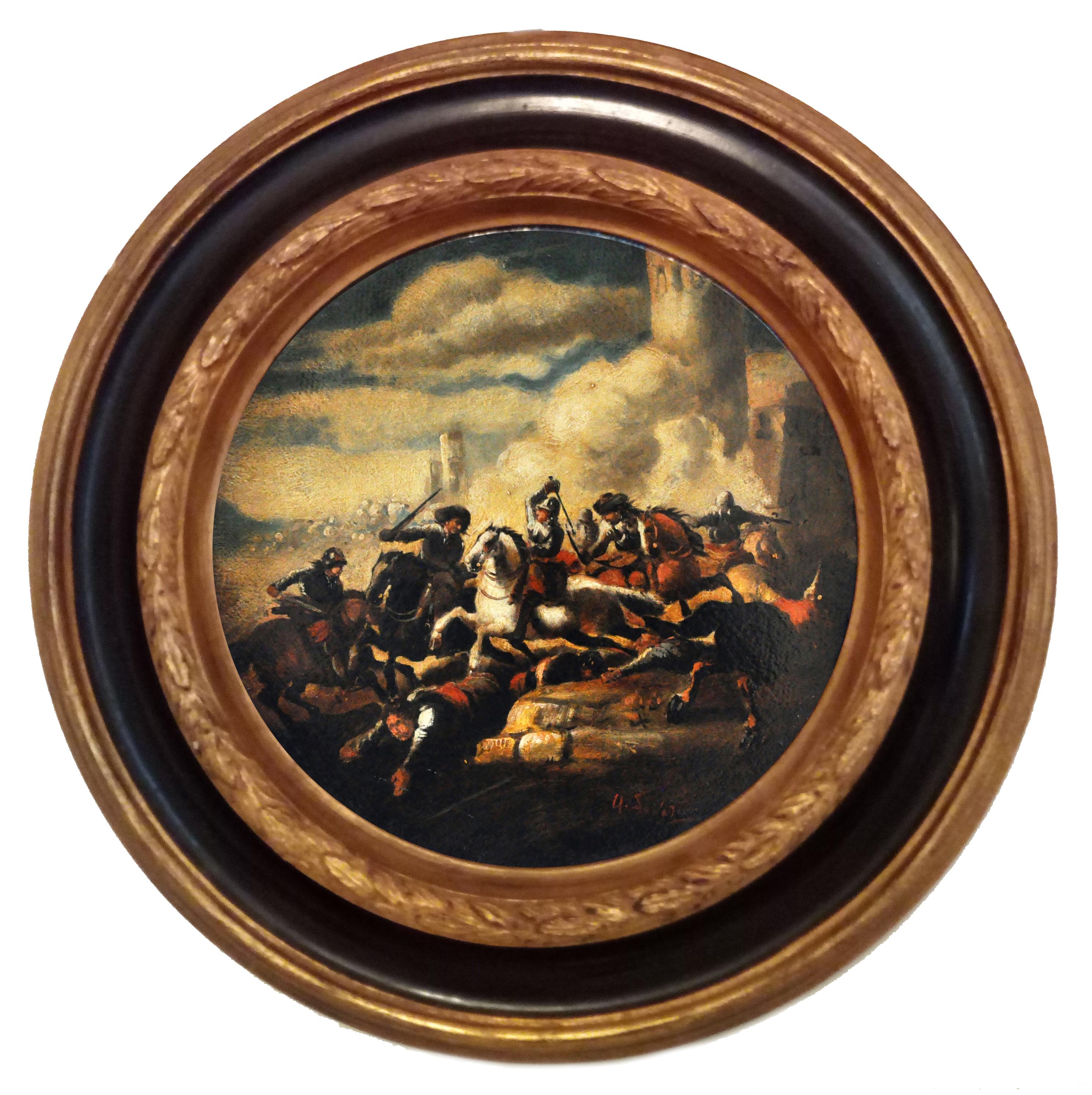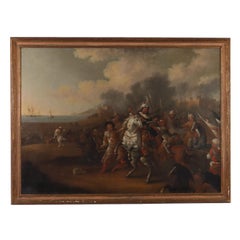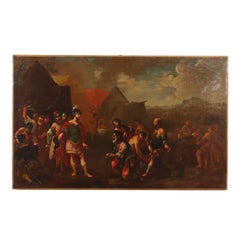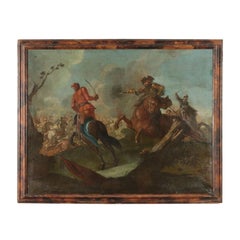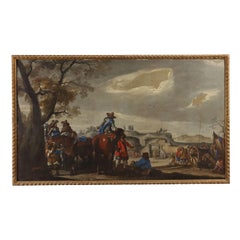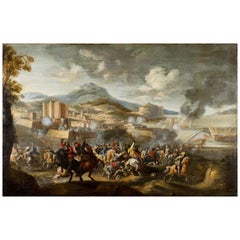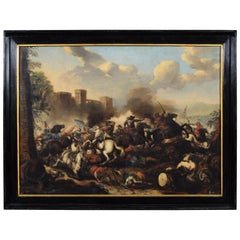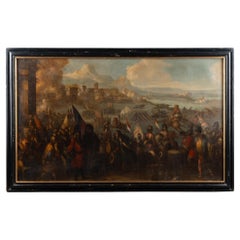Items Similar to Giovanni Boni Oil On Canvas 19th Century, Siege Scene
Want more images or videos?
Request additional images or videos from the seller
1 of 15
UnknownGiovanni Boni Oil On Canvas 19th Century, Siege Scene1800s
1800s
$7,720.07
$9,650.0920% Off
£5,743.66
£7,179.5720% Off
€6,448
€8,06020% Off
CA$10,755.64
CA$13,444.5520% Off
A$11,706.21
A$14,632.7720% Off
CHF 6,145.66
CHF 7,682.0720% Off
MX$141,428.15
MX$176,785.1820% Off
NOK 77,134.78
NOK 96,418.4720% Off
SEK 72,728.97
SEK 90,911.2220% Off
DKK 49,096.42
DKK 61,370.5220% Off
About the Item
Oil on canvas.
Outside the fortifications of a city, a commander, surrounded by his soldiers, is about to light the fuse of the cannon. The army defends the citadel outside the walls and the soldiers scan the horizon looking downwards: this leads us to place the scene on the fortifications of a city, in particular those of Genoa, that rise on the mountains behind it and from which the Genoese defended the city from attacks from the sea; the Genoa setting is also supported by the banner that flies over the walls, the Saint George Cross (red cross on a white background), flag of the Republic of Genoa. The shape of the armor, weapons and clothing would refer to the siege of Genoa in 1522.
It is therefore the nineteenth-century representation of a historical episode, which is then part of that pictorial production widespread in Italy in the nineteenth century, inspired by the new historical novel popular in literature.
On the back of the frame there is the name G. Boni, together with a number that refers to participation in an official exhibition.
Giovanni Boni was a pupil of the Brera Academy, in particular a follower of Giuseppe Sogni, an artist who was among the first to favour historical painting in its innovative romantic declinations.
Not much is known about Boni, neither from a biographical point of view nor from his production. Of his certain attribution we know only the Nude of Man (painted Academy) with which he won the first prize for the Scuola del Nudo in Brera in 1852.
The piece expresses the figures and the pathos of the scene with expressive efficiency; the characters in the foreground are very well characterized in their poses, expressions, in the details of the clothes and weapons, while the other figures fade into the background, suggesting the presence of a large army.
The painting, still on the first canvas, shows small widespread losses of colour. It is presented in a frame in style.
- Creation Year:1800s
- Dimensions:Height: 38.59 in (98 cm)Width: 49.22 in (125 cm)Depth: 1.97 in (5 cm)
- Medium:
- Period:
- Condition:
- Gallery Location:Milan, IT
- Reference Number:1stDibs: LU68038957242
About the Seller
4.8
Vetted Professional Seller
Every seller passes strict standards for authenticity and reliability
Established in 2017
1stDibs seller since 2017
126 sales on 1stDibs
Typical response time: 3 hours
- ShippingRetrieving quote...Shipping from: Milan, Italy
- Return Policy
Authenticity Guarantee
In the unlikely event there’s an issue with an item’s authenticity, contact us within 1 year for a full refund. DetailsMoney-Back Guarantee
If your item is not as described, is damaged in transit, or does not arrive, contact us within 7 days for a full refund. Details24-Hour Cancellation
You have a 24-hour grace period in which to reconsider your purchase, with no questions asked.Vetted Professional Sellers
Our world-class sellers must adhere to strict standards for service and quality, maintaining the integrity of our listings.Price-Match Guarantee
If you find that a seller listed the same item for a lower price elsewhere, we’ll match it.Trusted Global Delivery
Our best-in-class carrier network provides specialized shipping options worldwide, including custom delivery.More From This Seller
View AllPainting with Scene of Battle mid-18th century
Located in Milan, IT
Oil on Canvas.
The scene depicts a battle between an army of Moors and white soldiers, defending a fortification from which cannons are firing, while in the background a white city e...
Category
18th Century and Earlier Other Art Style Figurative Paintings
Materials
Oil
$4,769 Sale Price
20% Off
Painting with Historical Subject 17th-18th Century
Located in Milan, IT
Oil on Canvas.
The scene takes place at a military camp: outside a tent on the left a leader of an army, probably Greek, is receiving offerings of a group of men, poor and ragged, ...
Category
Late 17th Century Other Art Style Figurative Paintings
Materials
Oil
$6,513 Sale Price
20% Off
Battle Scene Oil On Canvas 17th Century
Located in Milan, IT
Oil on canvas. Mittel-European School. There is a No.S monogram on the back and numbers probably from an inventory. The painting reminds of pieces from the Austrian area. It represen...
Category
17th Century Other Art Style Figurative Paintings
Materials
Oil
$6,505 Sale Price
20% Off
Painting The Waiting for the Battle 18th century
Located in Milan, IT
Oil on Canvas.
The large-scale scene is set outside a rocky fortress and features a garrison of soldiers preparing for battle: in the left foreground, by a tree, the group of mounted...
Category
18th Century Other Art Style Figurative Paintings
Materials
Oil
$9,099 Sale Price
20% Off
Historical subject, XIXth century
Located in Milan, IT
Oil painting on canvas. Mid 19th century. The large scene tells an unidentified historical episode, set in the Renaissance period, in which an archbishop listens to the plea of a you...
Category
19th Century Other Art Style Figurative Paintings
Materials
Oil
$15,306 Sale Price
20% Off
Painting Alexander the Great conquers Jerusalem 19th century
Located in Milan, IT
Mixed media (pencil, pen, brown ink and white chalk) on paper. Italian school of beginning '800.
The scene depicts a meeting between a high priest and a leader: if the latter is fol...
Category
19th Century Other Art Style Figurative Paintings
Materials
Mixed Media
$5,229 Sale Price
20% Off
You May Also Like
17th Century, Italian Painting with Battle attributed to Marzio Masturzo
Located in IT
Marzio Masturzo, attributed (Active in Italy - in Naples and Rome- in the second half of the 17th century)
"Battle between cavalry and vessels with fortified city on the left"
...
Category
Antique Late 17th Century Italian Baroque Paintings
Materials
Canvas
$40,408 Sale Price
25% Off
17th Century Old Master Painting, Large Battle Scene, Oil on Canvas
Located in Bradenton, FL
17th Century Large Old Master Battle Scene Painting. Flemish School, circa 1610 - 1680. Oil on canvas painting depicts a dynamic battle scene fi...
Category
Antique 17th Century Dutch Baroque Paintings
Materials
Canvas
18th Century Italian Oil on Canvas Painting with Battle by Antonio Calza
By Antonio Calza
Located in IT
Antonio Calza (Italy, Verona, 1653-18th April 1725)
"Battle between Christian and Turkish cavalry with castle"
The painting depicts a bloody battle between Christian and Turkish cavalry. Characterized by dynamism, intensity of color and light, the main scene occupies the lower horizontal section of the canvas, optically interrupted by the black fumes of the shots from which emerge, on the left, the towers of a fortress. On the right, in the distance you can see the combat in progress in the countryside, beyond which you can see the pale presence of hills that create a fifth, marking the horizon. To frame the scene contributes to the left, against light and in the foreground, a portion of the wall. The painter, however, introduces a horse on the ground, of which we see only the back, a ruse to involve the observer making him become active and participate in the scene. In the foreground, lifeless bodies, wounded horses and, scattered on the ground, weapons and a drum enhance the drama of the clash.
The excitement and expressive force, the intense chromatic range attentive to the conditions of light and the fine brushstrokes, decisive and dramatic, suggests the attribution to Antonio Calza, one of the most important painters of battles of the seventeenth century, excellent student and continuator of the greatest interpreter of the genre, Jacques Courtois called il Borgognone (Saint-Hyppolite 1621 - Rome 1676). Il Borgognone, although not having had a real school or direct students, places itself as a primary reference point by the Italian and foreign "battaglisti".
The genre of battle painting found great success in the collections of the Italian and European nobility of the seventeenth and eighteenth centuries. The battles of the Italian Renaissance, in which the scene converged towards a precise protagonist, evolve towards a type of combat "without hero". The bloody realism of the details and the dynamic development of the narrative confuse the figure of the protagonist, when present, to give importance to the swirl of horses and armed fighters, among which, moreover, does not emerge a winner.
The certain documents relating to the life and movements of Antonio Calza are scarce; it was equally difficult to reconstruct, from the critics, a catalogue of autograph works. Through paintings in private collections, in museums and paintings passed on the antiques market it has been possible to identify a copious corpus of works that can be traced back to his hand. The work of art historians, together with that of antique dealers, in conferring proper attributions in order to best outline the figure of Calza, continues but studies are still in progress. In this sense, the work of Giancarlo Sestieri should certainly be noted, who investigated the artistic production of the battaglisti and Calza, thus allowing the comparison of the numerous photographic works reported, to identify and recognize the stylistic qualities that distinguish the corpus of paintings assigned to him today.
Antonio Calza was born in 1653 in Italy, in Verona and in 1664 he entered the school of Carlo Cignani in Bologna, dedicating himself to painting battles and landscapes. He then perfected in Rome, where he knew the works of the then undisputed head of the sector, Jacques Courtois called the Burgundian. In 1675 he returned to Verona and married an 88-year-old widow who, dying, left him a rich inheritance. Much appreciated by the nobility and the bourgeoisie, he received numerous commissions. Bartolomeo Dal Pozzo (Le Vite de' pittori, de gli scultori et architetti veronesi, 1718) praises "three great paintings of battles...
Category
Antique Late 17th Century Italian Baroque Paintings
Materials
Canvas
Mid 19th Century Large Original Oil on Canvas Painting of Battle Scene Surrender
Located in Round Top, TX
Large original oil on canvas painting of battle scene with a defeated commander surrendering. Unsigned.
Ascribed to Jacques Courtois (b. Saint-Hip...
Category
Antique Mid-19th Century Danish Paintings
Materials
Canvas, Wood, Paint
CAVALRY BATTLE - Antonio Savisio Neapolitan School Italy Oil on canvas Painting
By Antonio Savisio
Located in Napoli, IT
Land Battle - Antonio Savisio Italia 2006 - Oil on canvas diam. cm. 30
Gold leaf gilded and laquered wooden frame cm. 47x47
Maestro Antonio Savisio drew inspiration from the masterp...
Category
Early 2000s Old Masters Figurative Paintings
Materials
Canvas, Oil
CAVALRY BATTLE Antonio Savisio Neapolitan School Italian Figurative Oil Painting
By Antonio Savisio
Located in Napoli, IT
Land Battle - Antonio Savisio Italia 2006 - Oil on canvas diam. cm. 30
Maestro Antonio Savisio drew inspiration from the masterpieces of the great Neapolitan Maestro Salvator Rosa w...
Category
Early 2000s Italian School Figurative Paintings
Materials
Canvas, Oil
